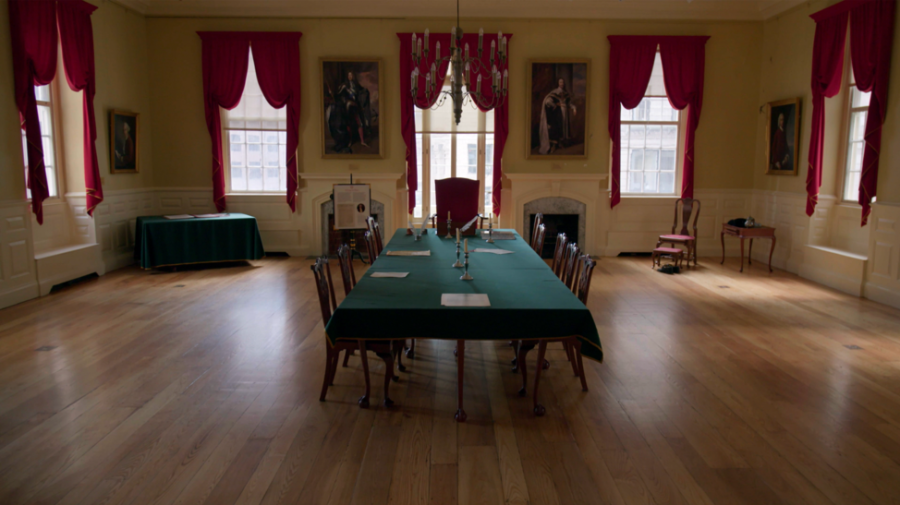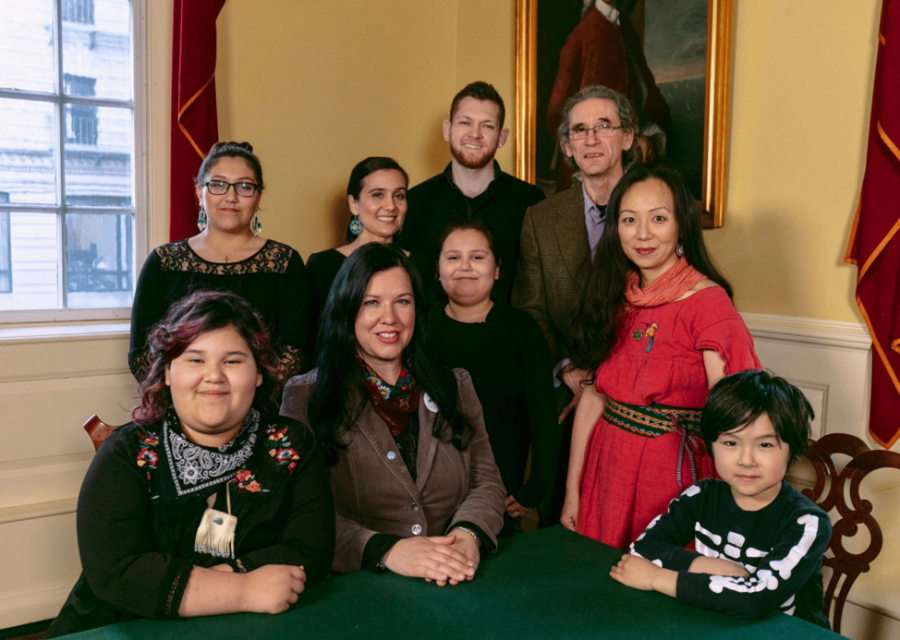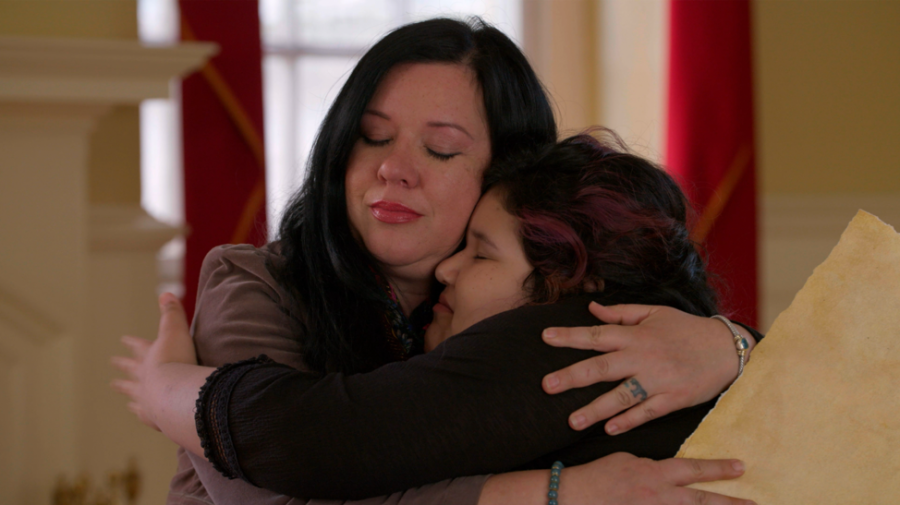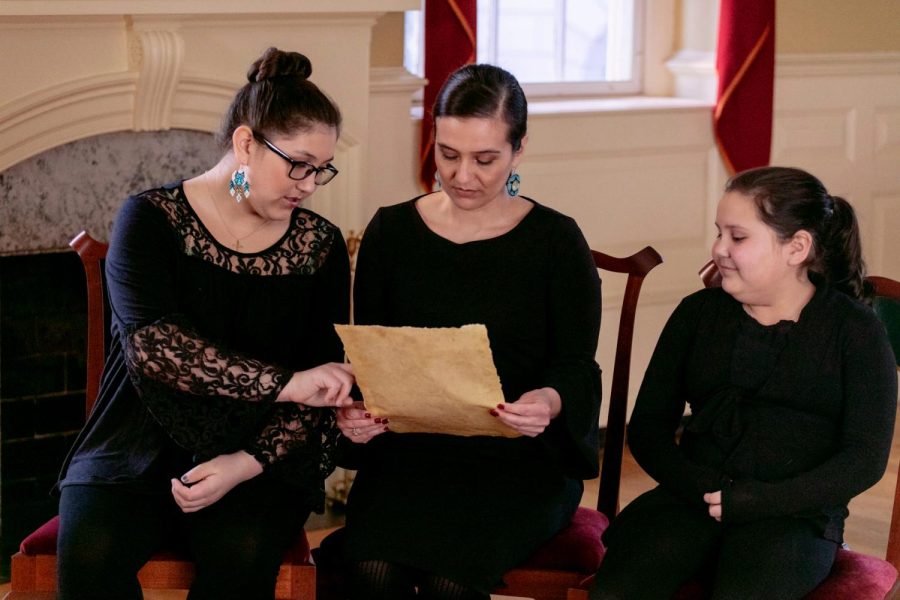“Bounty” shifts documentary filmmaking by centering Indigenous voices
“The more people have tried to oppress us, the harder we fight back.”
Documentary filmmakers at the Upstander Project have become deeply committed to a different way of filmmaking, according to the Boston-based nonprofit’s co-founder and director Adam Mazo. Central to that mission is overcoming indifference to social injustice by creating compelling documentary films that center the voices of those most impacted to reach the heart of social issues. The accompanying learning resources distributed alongside the film are part of a broad impact strategy that contextualizes the films for educators and general audiences while pointing them toward action-oriented campaigns for social change.
By collaborating with the Indigenous American communities that their work documents, the Upstander Project hopes to create film and teaching tools that serve these communities, not just outsiders.
“We feel like if we’re not serving the community, then we’re doing a disservice. We can be doing harm. We can be perpetuating injustice,” said Mazo.
Mazo and his team are also driven to change the landscape of the documentary genre, which was born out of extractive colonial practices, by forging a new path with Indigenous partners to tell their stories with sensitivity and nuance.
The project was formed in 2009 with their first documentary, “Coexist,” a critically acclaimed film that conveyed the story of the government-mandated reconciliation efforts of the 1994 genocide in Rwanda through the eyes of survivors. The film was positively received — nominated best documentary at the Africa Movie Academy Awards — and the accompanying teacher’s guide was adopted by more than 3,500 educators nationwide. In the wake of this success, Mishy Lesser, co-founder and learning director for the Upstander Project, worked with Mazo to expand the organization’s scope and shift the focus toward the genocidal acts that have harmed Indigenous peoples locally.
“Dawnland,” the project’s second feature-length documentary, was released in 2018. The Emmy-award-winning film followed the Maine-Wabanaki State Child Welfare Truth and Reconciliation Commission. The commission was formed to respond to the forcible removal of Indigenous children and replacement in white homes as part of a systematic attempt to assimilate them and eradicate their connections to their cultural heritage. Even after the success of Dawnland, the filmmakers still felt elements of the themes of generational trauma and the continued effects of colonialism remained unexplored, which led to their most recent project.
 |
| “Bounty” was filmed in the Old State House, which is a popular destination on the Freedom Trail and also where the scalp bounty was signed. (Photo: Courtesy of the Upstander Project) |
“Bounty” premiered on Nov. 10. According to Mazo, over 2,500 people registered for the online event. They had to create a second screening to accommodate almost 1,600 attendees. This short film epitomizes the project’s mission to incorporate Indigenous perspectives. Mazo joined forces with Penobscot families for every stage of the production. The film’s co-directors included Dawn Neptune Adams, an Indigenous activist, and Maulian Dana, the Penobscot tribal ambassador.
“Bounty” features three Penobscot families as they read from the Phips Proclamation, a scalp bounty issued in 1775 that rewarded settlers with money and land for the brutal murder of their ancestors. The document was signed in the Council Chamber, a room in the Old State House in Boston, on the unceded territory of the Massachusett people and their neighbors, the Wampanoag and Nipmuc Nations.
This proclamation is just one example of rewarding settlers for the murder of Indigenous people. According to the Upstander Project’s research, at least 69 government-issued scalp edicts across the area now known as New England from 1675 to 1760. Across the land that would become the United States, at least 30 more were issued between 1675 and 1862.
Through “Bounty,” Penobscot families use the Phips Proclamation to process the larger trauma of this continued genocide of their people and culture. Making the film brought them together to reclaim space and share their stories, which had been unknown to most Americans for too long, suppressed and rewritten to exclude Indigenous voices.
The Scope spoke with Mazo, along with Neptune Adams, Dana and her daughter, Carmella Bear, to hear more about what made the film unique, both in content and production. The conversation has been edited for length and clarity.
On collaborating with the Upstander Project:

Adams: One of the best things about the Upstander Project is not just the documentaries, it’s everything around it. It’s the whole media ecosystem that surrounds the story where people can find any number of information resources. It’s their focus on decolonizing and giving people, settlers especially, a path to standing in solidarity with other oppressed peoples and us.
Dana: The experience was really wonderful. We really trust the Upstander team and the project, and I remember after I saw “Dawnland,” I thought that they were really onto something special. They were telling these very traumatic and painful stories about our people in a very unflinching way, but in a way that gives so much space for healing and so much support to the people telling the stories.
We’re going to talk about this really sad story, but we’re going to do it together. I think that that made a big difference, having three Penobscot families processing it together with a whole lot of support and care for everybody involved.
We had children involved. So I think there was extra care taken to make sure that even though we were dealing with really heavy topics, we were doing it in a good way … that benefited the adults as well. I think that helped us process a lot of that dark history. The collaboration between the Penobscot families and the filmmakers was very seamless and very continual. So I think it made for a really positive and empowering experience.
Mazo: Unfortunately, the litany of genocide and human rights abuses against Indigenous people and so long that we couldn’t fit it all into “Dawnland.” We also weren’t sure that we could do the story justice. It’s good that we took time with it because it allowed us to approach the filmmaking differently and make the film with Penobscot families, with Mualina and Dawn Neptune Adams as co-directors of the film and their families as participants as opposed to subjects.
On filming in the Old State House and reclaiming space:
Neptune Adams: I never stepped foot inside the statehouse, and it was at first, it was a really oppressive feeling like you could feel the weight of history bearing down. After all these years, I feel uncomfortable in rooms where there are old white guys on the walls staring down at us … We really leaned on each other, not only the other Penobscot people there but the crew. And it was a good team experience, even as oppressive as those walls were.
Reclaiming space is a recurring theme not only in my life but in the lives of many people. It did feel like we were counting coup for our ancestors.
Bear: To read that writing and be at the place where it was signed, it definitely sent a little bit of a shock — actually being there, holding a copy of it and being in the room where it was placed was very emotional and heavy. Not the type of emotional where you’re crying and sobbing, but the type of emotional where the air feels extremely heavy. But working with adults who understood that very much provided a safe place and a safe experience, and it felt really good to have sort of a support group that understood.
To be able to have that experience of closure and just gratification of fully understanding what had happened, to be able to be where it happened. There is a lot of sadness and heaviness that comes with that, but I am so thankful that I was able to feel that firsthand at such a young age. Not a lot of people get to do that. So to be a part of a group that had been oppressed for so long, it felt really good at 12 years old to be at the place where everything went down. So the closure just feels so great.
Mazo: Really important for us in Boston is that we would love to see this film permanently installed in the Council Chamber in the Old State House. How could you have a room like that in a story like that and not have that history be part of that space? Millions of people walk the Freedom Trail and know nothing about the genocide that was perpetrated right there?
On the impact of the film:

Neptune Adams: I think that settler descendants might have a fear of looking back at their ancestors and feeling guilt or, you know, feelings of shame. And that part of the fear is having to own it and process it.
The more we share our histories, the easier it is to understand one another and the easier it is to live alongside one another in this land that we now share.
There’s going to be an initial period of shock, but when they go through the “Bounty” media ecosystem and the teacher’s guide, I think it will prepare them to be in solidarity with us and to help amplify us when needed.
Dana: I hope people walk away with a new awareness about these genocidal acts that happened right in our homelands here. It doesn’t mean we have to hate each other or that there is blaming or shaming involved. It’s just that we’re going to work a lot better together if we’re all aware of our true histories.
Bear: When people see this movie, I hope they take away that we’re still here. I really hope that the people who have been living under a rock and haven’t been paying attention to this sort of stuff realize … a sort of groundbreaking realization that like, ‘Wow, this did happen. We weren’t lying.’
Mazo: Something that’s really important that we hope people will understand from engaging with the film and the whole media ecosystem around it and the teacher’s guide is that this proclamation was one of 69 different scalp bounties targeting native peoples across the Dawnland. This went on for decades and decades, and it’s part of a systematic tool used by the English colonial authorities to exterminate Indigenous people and seize the land that became the United States. This was not just one incident, but that this was part of a broad-based strategy. We focus on one proclamation as an entry point to exploring the larger issue. Also, to say that Penobscot people are still here. To say that it was English settlers who were doing the scalping of Indigenous people. And those two things are not widely known.
While the film does talk about their really horrible, horrible things — murder and scalping incidents — it’s also a testament to the resistance of Indigenous people in survival and in remembrance and working for justice. Those are two intentional choices by our team to face this really painful, bloody history but do it in a way that we hope builds solidarity and Indigenous protagonism and encourages and creates other pathways for Indigenous people to be authors of their stories.
On the importance of Indigenous visibility:
Dana: America and Canada have always had a real problem telling the truth when teaching history. We learn in public school, Columbus, Thanksgiving and all these very watered-down, candy-coated portrayals of times and history that involve Indigenous people who either ignore us or make it seem like we were the enemy, and we were defeated and then America progressed.
That’s just as harmful, and that makes us just as invisible. Knowing that people will learn about the Holocaust of World War II and that genocidal acts happened right on this soil … that’s not just healing and uplifting for Indigenous people. I think it helps everybody to know the real truth about history.
Bear: I’m extremely grateful to be the generation where our history is talked about and where we are represented because my mom’s generation [and] my grandmother’s generation … they did not have any representation in the media. They didn’t have any representation in surrounding communities, so I’m very lucky in the fact that I get to share this with so many people. Millions of people will know what we went through, our experiences and they’re going to know about us.
Mazo: The erasure of Indigenous people here in this region is so intense. The names are there; they’re in the rivers, streets and racist portrayals on the Massachusetts state flag and seal. They’re deeply embedded, almost subliminally, in our public consciousness. But they’re not there in our classrooms and in our schools. If they are there, it’s largely locked in time as people who were around for this mythologized first Thanksgiving in 1621 — that we’re going to be celebrating the 400th anniversary of — but people are still here in Massachusetts. Settlers need to listen to them and learn from them.
Indigenous history, Native American history, particularly, is U.S. history. The history of these lands goes back thousands and thousands of years long before it was the United States. Particularly in the dawn land, which has been rebranded as New England, the place where the sun first looks our way … we need to understand how we settlers like me came to be here and understand that people understand the contributions of Wampanake and Wampanoag other people of the first light, people of the dawn had made through many, many millennia long before English settlers arrived.
We would love to see this film in the teacher’s guide used in every school in the country. I mean, especially so-called New England, the Dawnland, we don’t want another generation to grow up not learning this history.
On the continued thread of genocide and colonization:

Adams: These things ricochet through time. Colonization didn’t end. It just changed form.
Back when the Scout proclamation was signed, many of the bounty hunters were awarded land and water along with the exorbitant fee they were paid.
The cultural genocide, it’s not as bloody as taking off the top of my head, but the colonization — the taking of the land and water that happened as the result of the scalp bounties — continues in different forms today.
Right now, the Penobscot Nation is dealing with cultural genocide and environmental racism.
Dana: You can see that thread from colonization and some of these early acts of violence against us and some of the things we’re still dealing with, you know, that echoes.
My kids, it feels like they’re much older now … And so they’re connecting those genocidal acts with some of the conditions we’re living under today and some of these cycles of poverty and oppression, negative health outcomes, and crime in our communities and addiction.
Mazo: We don’t want to focus on the brutality of scalping itself, even though it was, of course, brutal. We want to focus on how settlers terrorize native people … declaring genocide on any group of Indigenous people had the effect of giving a license to kill all Indigenous people.
On working alongside settlers:
Neptune Adams: A lot of my work is with settlers. I am two-spirit, and I walk in two worlds. I was raised in an upper-middle-class white home, but I also have my native roots and connection to my culture. So I can walk in either world. I can walk in the Indigenous world. I can walk with settlers and invite them to be in solidarity with us.
One of the ancestors on my grandmother’s side of the family, I’m kind of following in her tradition. Her name was Lucy Nicola, and she was also known as her stage name Princess Watahwaso. She was often criticized for playing to white or settler audiences. But you know what? If you have a knack for that, go ahead and do it — any way you can make change.
The most important thing is learning if settlers can learn about the people from the land where they currently live. That would be the first big step. Amplification is huge. It wasn’t until we rallied our neighbors that we started to be heard because they amplified us. That’s a way that settlers can leverage their power to help us.
The turnout has been one of the most hopeful things because it shows that people care. It shows that they are willing to learn.
Dana: We’ve done a really good job at holding our identities and our cultures together in the face of so much, so to think that other people are intrigued by these stories, and feeling some kind of connection or draw to them … I think that speaks a lot for humanity, that you can take yourself out of yourself and walk in someone else’s shoes and want to learn about them and want to help them.
Mazo: Being an upstander is a project that we can all work towards throughout our journeys. By naming ourselves the Upstander Project, it’s not a declaration that we are Upstanders … it’s a declaration that being an upstander is kind of a lifelong project, just like being a hero, or an ally or a champion.
On colonial attempts at oppression and native resilience:
Neptune Adams: I lived on Indian Island until I was four when I was stolen and placed in non-native foster care in a white, upper-middle-class neighborhood. That’s where I now live, not in the foster home, but the same town, literally on the land that was stolen from my grandfather’s side of the family. It was very racist and very abusive in the foster home. It’s not necessarily the color of your skin. If someone knows you’re Penobscot, that can get you targeted. I never gave up my identity. People will say that we lost [our identity] in foster care, but you don’t lose things like that. It’s stolen.
The more people have tried to oppress us, the harder we fight back. And again, we’re still here. We Penobscot people are numbered at about 2,800, and we’re all across this nation. We are still practicing our culture. We are still defending our relatives, both human and non-human alike — the land, the water and all our relations.
I’ve sometimes heard Indigenous people described as being vulnerable, and that is not the case. We are targeted and marginalized. But we are very resilient.
Dana: It wasn’t that long ago we were having children stolen from our families. This has been, you know, another genocidal act because it was really targeting our culture and our identity by forcing assimilation on our children. Seeing these three very distinct and very different Penobscot families, we all have the honor and the joy of raising our own children and having them in connection with our families and our communities … all being able to do something that a lot of people a generation before us weren’t. That really made me feel hopeful.
There will be a virtual live screening of “Bounty” and Q & A featuring Neptune Adams, Dana, Mazo and Lesser on Jan. 20, 2022, at 7:00 p.m. “Bounty” is also available to purchase and stream online now. “Dawnland” will air on Saturday, November 20 at 9 p.m. on PBS.



Comments